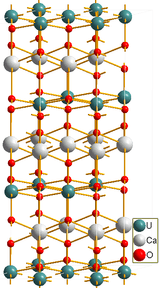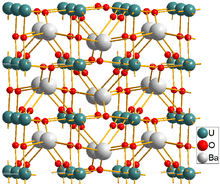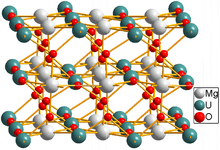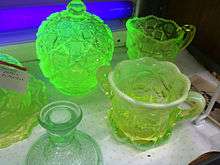Uranate
A uranate is a ternary oxide involving the element uranium in one of the oxidation states +4, +5 or +6. A typical chemical formula is MxUyOz, where M represents a cation. The uranium atom in uranates(VI) has two short, co-linear, U-O bonds and either four or six more next nearest oxygen atoms.[1] The structures are infinite lattice structures with the uranium atoms linked by bridging oxygen atoms. "Ammonium diuranate" is an intermediate in the production of uranium oxide nuclear fuels.
Synthesis
A method of general applicability involves combining two oxides in a high temperature reaction.[2] For example,
- Na2O + UO3 → Na2UO4
Another method is the thermal decomposition of a complex, such as an acetate complex. For example, microcrystalline barium diuranate, BaU2O7 was made by thermal decomposition of barium uranyl acetate at 900 °C.[3]
- Ba[UO2(ac)3]2 → BaU2O7 + ... (ac=CH3CO2−)
Uranates are insoluble in water and other solvents, so pure samples can only be obtained by careful control of reaction conditions.[2]
Naturally occurring uranates are rare and always occur as secondary minerals. Examples include curite, becquerelite and soddyite named after prominent radiochemists Pierre Curie and Marie Curie, Henri Becquerel and Frederick Soddy, respectively.[4] Uranates can be prepared by adding alkali to an aqueous solution of a uranyl salt. However, the composition of the precipitate that forms is variable and depends on the chemical and physical conditions used.
Uranium (VI)
Structures


All uranates(VI) are mixed oxides, that is, compounds made up of metal(s), uranium and oxygen atoms. No uranium oxyanion, such as [UO4]2− or [U2O7]2−, is known. Instead, all uranate structures are based on UOn polyhedra sharing oxygen atoms in an infinite lattice.[1] The structures of uranates(VI) are unlike the structure of any mixed oxide of elements other than actinide elements. A particular feature is the presence of linear O-U-O moieties, which resemble the uranyl ion, UO22+. However, the U-O bond length varies from 167 pm, which is similar to the bond length of the uranyl ion, up to about 208 pm in the related compound α-UO3, so it is debatable as to whether these compounds all contain the uranyl ion. There are two principal types of uranate which are defined by the number of nearest-neighbour oxygen atoms in addition to the "uranyl" oxygens.[1]
In one group, including M2UO4 (M=Li, Na, K) and MUO4 (M=Ca, Sr) there are six additional oxygen atoms. Taking calcium uranate, CaUO4, as an example, the six oxygen atoms are arranged as a flattened octahedron, flattened along the 3-fold symmetry axis of the octahedron which also runs through the O-U-O axis (local point group D3d at the uranium atom). Each of these oxygen atoms is shared between three uranium atoms, which accounts for the stoichiometry, U + 2×O + 6×1/3 O = UO4. The structure has been described as a hexagonal layer structure. It can also viewed as a distorted fluorite structure in which two U-O distances have decreased and the other six have increased.[1]
In the other group, exemplified by barium uranate, BaUO4, there are four additional oxygen atoms. These four oxygens lie in a plane and each is shared between two uranium atoms, which accounts for the stoichiometry, U + 2×O + 4×1/2 O = UO4. The structure may called a tetragonal layer structure.[1]

Magnesium uranate, MgUO4, has a quite different structure. Distorted UO6 octahedra are linked into infinite chains; the "uranyl" U-O bond length is 192 pm, not much shorter than the other U-O bond length of 218 pm.[1]
A number of so-called diuranates are known. They fall into two categories, compounds of exact composition, synthesized by combination of metal oxides or thermal decomposition of salts of uranyl complexes and substances of approximate composition, found in yellowcake. The name refers only to the empirical formula, MxU2O7; the structures are completely different from ions such as the dichromate ion. For example, in barium diuranate, BaU2O7, UO6 octahedral units are joined by sharing edges, forming infinite chains in the directions of the crystallographic a and b directions.[3]
Uranates with more complicated empirical formulas are known. Essentially these arise when the cation:uranium ratio is different from 2:1 (monovalent cations) or 1:1 (divalent cations). Charge-balance constrains the number of oxygen atoms to be equal to half the sum of charges of the cations and uranyl groups. For example, with the cation K+, compounds with K:U ratios of 2, 1 and 0.5 were found, corresponding to empirical formulas K2UO4, KUO3 and K2U4O13.[8] The uranate structures in these compounds differ in the way the UOx structural units are linked together.
Halo-uranates are compounds in which one oxygen atom is replaced by two halogen atoms. For example, CaU2O6F2 is described as an "isotype" of the oxide U3O8.[9] In the structure of the oxyfluoride, UO2F2, there is the same hexagonal layer structure as in CaUO4.[1] Other anions, such as nitrate, can also be present in uranates.
Properties and uses

Yellowcake is produced in the separation of uranium from other elements, by adding alkali to a solution containing uranyl salts.[10]
When the alkali used is ammonia, so-called ammonium diuranate, known in the industry as ADU, is the main constituent of yellowcake. The exact composition of the precipitate depends to some extent on the conditions and anions that are present and the formula (NH4)2U2O7, is only an approximation. The precipitates obtained on addition of ammonia to uranyl nitrate solution under different conditions of temperature and final pH, when dried, were considered as loosely bound compounds with an ammonia/uranium ratio of 0.37 containing varying amounts of water and ammonium nitrate.[11] In other studies it was found to approximate to the gross formulas 3UO3·NH3·5H2O,[12] The asymmetric stretching frequency of the uranyl ion was found to decrease with increasing NH4+ content. This decrease is continuous and no band splitting was observed, indicating that the ammonium uranate system is homogeneous and continuous.[13]

ADU is an intermediate in the production of uranium oxides to be used as nuclear fuel; it is converted directly into an oxide by heating. βUO3 is produced at about 350 °C and U3O8 is obtained at higher temperatures. When the alkali used is sodium hydroxide, so-called sodium diuranate, SDU, is produced. This can also be converted into an oxide. Another choice of alkali is magnesium oxide, making magnesium diuranate, known as MDU.
Oxides and uranates of uranium(VI) have been used in the past as yellow ceramic glazes as in Fiesta and to make yellow-green uranium glass.[14] Both of these applications are abandoned due to concern regarding radioactivity of the uranium. Uranates are important in radioactive waste management.[15]
Uranium(V)
Three series of uranates(V) have been characterized. Compounds with the formula MIUO3 have a perovskite structure. Compounds MI3UO4 have a defect rock-salt structure. MI7UO6 structures are based on a hexagonally close-packed array of oxygen atoms. In all cases the uranium is at the centre of an octahedron of oxygen atoms. Few other compounds of uranium(V) are stable.[2]
Uranium(IV)
Barium uranate, BaUO3, is made from barium oxide and uranium dioxide in an atmosphere that contains absolutely no oxygen. It has a cubic crystal structure (space group Pm3m).[16] An extensive series of non-stoichiometric mixed oxides exists. The UO2/PuO2 system is important in the fuel of fast breeder reactors.[2] Cerium uranium blue, of variable formula CexU1–xO2, has a structure similar to the fluorite structure.[17]
References
- 1 2 3 4 5 6 7 Wells, A.F (1962). Structural Inorganic Chemistry (3rd. ed.). Oxford: Clarendon Press. pp. 966–969. ISBN 0-19-855125-8.
- 1 2 3 4 Greenwood, Norman N.; Earnshaw, Alan (1997). Chemistry of the Elements (2nd ed.). Butterworth-Heinemann. p. 1269. ISBN 0-08-037941-9.
- 1 2 Allpress, J.G. (1965). "The Crystal Structure of Barium Diuranate". J. Inorg. Nucl. Chem. 27 (7): 1521–1527. doi:10.1016/0022-1902(65)80013-6.
- ↑ Pough, Frederick H. (1988). A Field Guide to Rocks and Minerals (5th ed.). Houghton Mifflin. p. 159. ISBN 0-395-91097-8.
- 1 2 Loopstra, B. O.; Rietveld, H. M. (1969). "The structure of some alkaline-earth metal uranates". Acta Crystallogr. B. 25: 787–791. doi:10.1107/S0567740869002974.
- ↑ W. H. Zachariasen (1954). "Crystal chemical studies of the 5f-series of elements. XXI. The crystal structure of magnesium orthouranate". Acta Crystallogr. 7: 788–791. doi:10.1107/S0365110X54002459.
- ↑ Atoji, M.; McDermott, M. J. (1970). "The crystal structure of anhydrous UO2F2". Acta Crystallographica Section B. 26 (10): 1540–1544. doi:10.1107/S0567740870004454. ISSN 0567-7408.
- ↑ Van Egmond, A.B.; Cordfunke, E.H.P. (1976). "Investigations on potassium and rubidium uranates". J. Inorg. Nucl. Chem. 38 (12): 2245–2247. doi:10.1016/0022-1902(76)80203-5.
- ↑ Fonteneau, G.; L'Helgoualch, H.; Lucas, J. (1975). "CaU2O6F2, un fluorouranate isotype de U3O8". Inorg.Nucl. Chem. Letters. 11 (3): 207–212. doi:10.1016/0020-1650(75)80125-5.
- ↑ Hausen, D. M. (1961). "Characterizing and classifying uranium yellow cakes: A background". Journal of the Minerals, Metals and Materials Society. 50 (12): 45–47. Bibcode:1998JOM....50l..45H. doi:10.1007/s11837-998-0307-5.
- ↑ Ainscough, J.B.; Oldfield, B.W. (1962). "Effect of ammonium diuranate precipitation conditions on the characteristics and sintering behaviour of uranium dioxide". Journal of Applied Chemistry. 12 (9): 418–424. doi:10.1002/jctb.5010120907.
- ↑ Cordfunke, E.H.P. (1962). "On the uranates of ammonium—I: The ternary system NH3---UO3---H2O". J. Inorg. Nucl. Chem. 24 (3): 303–307. doi:10.1016/0022-1902(62)80184-5.
- ↑ Stuart, W.I; Whateley, T.L. (1969). "Composition and structure of ammonium uranates". J. Inorg. Nuclear Chem. 3. 1 (6): 1639–1647. doi:10.1016/0022-1902(69)80378-7.
- ↑ Skelcher, Barrie (2002). The Big Book of Vaseline Glass. Atglen, PA: Schiffer Publishing Ltd. ISBN 0-7643-1474-2.
- ↑ Saling, James H.; Audeen W. Fentiman (2002). Radioactive Waste Management (2 ed.). New York: Taylor & Francis. p. 2. ISBN 1-56032-842-8. Retrieved 2011-02-12.
- ↑ Barrett, S. A.; Jacobson, A. J.; Tofield,B. C.; Fender,B. E. F. (1982). "The preparation and structure of barium uranium oxide BaUO3+x". Acta Crystallogr. B. 38: 2775–2781. doi:10.1107/S0567740882009935.
- ↑ Magneli, Arne; Kihlborg, Lars (1951). "On the Cerium Doxide – Uranium Dioxide System and "Uranium Cerium Blue"". Acta Chem. Scand. 5: 578–580. doi:10.3891/acta.chem.scand.05-0578.
Further reading
Burns, C. J.; Neu, M.P.; Boukhalfa, H.; Gutowski, K. E.; Bridges, N. J.; Roger, R. D. (2004). "Chapter 3.3, The Actinides". Comprehensive Coordination Chemistry II. Elsevier. pp. 189–345. doi:10.1016/B0-08-043748-6/02001-6. ISBN 0-08-043748-6.